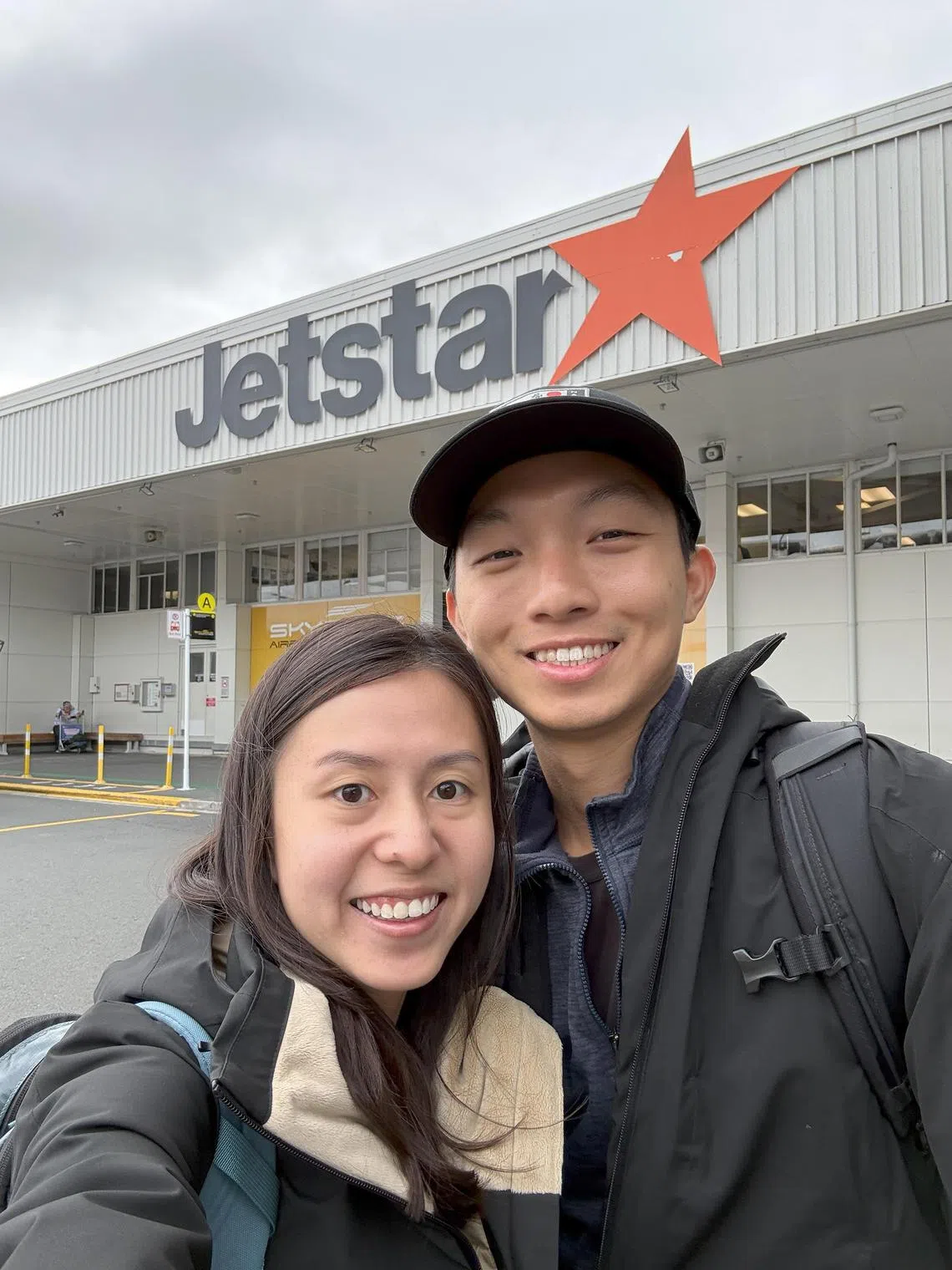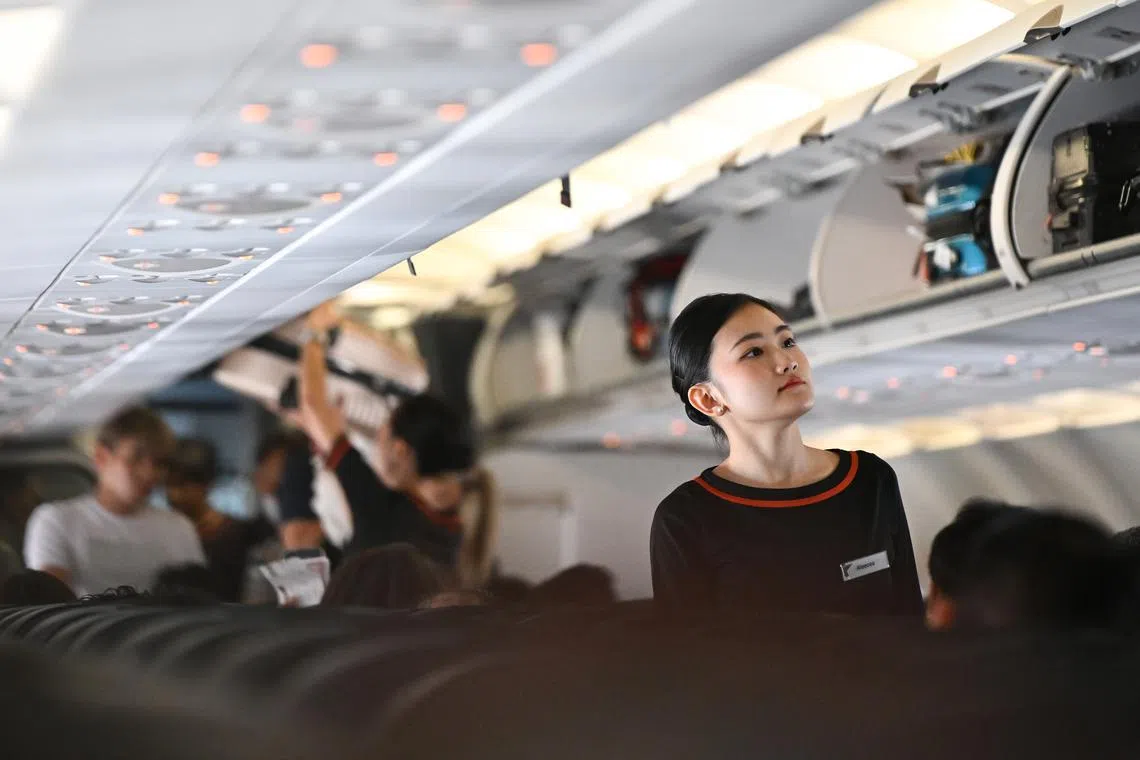20 years of budget aviation
Have budget carrier, will travel: Singaporeans venturing abroad more often and exploring new routes
Sign up now: Get ST's newsletters delivered to your inbox

Budget airlines have made it cheaper and more convenient for millions worldwide to fly.
PHOTOS: COURTESY OF FARED JHI, MAXIMILIAN TAY, TOM LIM AND KATE YAP, MARILYN CHEW AND LOW JIAN SHENG
Follow topic:
SINGAPORE – Jetting off to Kuala Lumpur and other South-east Asian cities for short breaks has become a routine for Mr Fared Jhi.
The graphic designer, 27, travels more than six times a year on low-cost carriers.
All that is possible because budget airlines have made it cheaper and more convenient for Mr Fared and millions of others worldwide to fly.
A two-way ticket on an AirAsia flight from Singapore to the Malaysian capital could cost around $240 on a budget airline with additional baggage – about $70 cheaper than on a full-service carrier, said Mr Fared.
“At the end of the day, we’re all in the same ‘metal tube’ heading to the same destination,” he quipped, when asked why he chooses budget airlines over full-cost ones.

Mr Fared Jhi holidaying solo in Cam Ranh, Vietnam, in October.
PHOTO: COURTESY OF FARED JHI
Sticking to a budget
Budget carriers have made a name for themselves here in the 20 years since Singapore’s first low-cost flight took off from Changi Airport in 2004.
Retired regional audit and controls adviser James Loo, 75, told The Straits Times that he can travel more frequently – up to four times a year – within a fixed budget, since the cost of a budget flight is often lower than that of a full-service carrier.
When he flew to Perth, Australia, in November, his return ticket on budget airline Scoot cost around $500 – half the price of an economy-class seat on parent company Singapore Airlines.
A regular business-class passenger when he travelled for work previously, Mr Loo said the transition has been “relatively easy” since he takes shorter flights now and does not need the perks offered by full-service carriers.
He said cheaper flights have been more of a draw for him since he retired in 2018. He likened taking a budget flight to taking a bus because he seeks pleasure “not in the journey but the destination”.
Similarly, housewife Rekh Raju takes budget flights four or five times a year, mostly on Indian budget carrier IndiGo. She said her experiences on low-cost airlines are “very similar” to those on full-service carriers, as the flights are of similar duration and take her to the same destinations.
The 48-year-old said the only notable difference was the absence of in-flight meals built into the ticket price.
She does not mind this, as taking low-cost flights has allowed her to cut her budget for flying by as much as half, compared with taking full-service flights whenever she visits friends and family in India.
Long-haul flights a no-go
But some travellers, such as engineer Tom Lim and housewife Kate Yap, told ST that they prefer budget airlines only when they are visiting nearby destinations in South-east Asia, and not places farther afield.
As a result, shopping in Bangkok and weekend getaways in Bali have become commonplace for the husband and wife in their 40s.
The ability to take these short trips means they no longer have to plan their travels strategically, which they did in the past because of higher fares on full-service airlines.
Mr Lim and Ms Yap said that because budget airlines usually offer a no-frills experience, the flight is reduced to being a mode of transport rather than a product to “enjoy and savour”.
They added that they would choose to fly to nearby locations on budget airlines because they do not need to pack too much and would not need check-in baggage allowance.
Nevertheless, the couple did travel to Athens, Greece, in 2022 on a 12-hour Scoot flight, which was the longest budget flight they had taken. This was because it was the only airline that flew non-stop between Singapore and Athens, and cost almost half the price of a regular ticket on a full-service carrier.

Mr Tom Lim and his wife Kate Yap travelled to Athens in 2022 via Scoot. Pictured here are their stuffed bears at the Acropolis.
PHOTO: TOM LIM AND KATE YAP
Mr Lim said being “cooped up” in a seat for 12 hours without food or entertainment that would otherwise have come with using a full-service airline was “trying”, though they still managed to get by with pre-downloaded electronic books on their phones.
He noted that they may consider taking long-haul budget flights again, but only if they can save 30 per cent or more on the air tickets compared with those sold by full-service airlines.
Husband and wife Low Jian Sheng, 30, and Marilyn Chew, 31, typically take budget flights that are shorter in duration and distance within the region, as this allows them to visit more destinations using their annual travel budget.
On how they decide between a low-cost carrier and a full-service airline, Ms Chew, a partnerships manager, and Mr Low, a software engineer, would consider several factors.
These include whether they need in-flight amenities, if the departure and arrival times are ideal for their schedule, and if they are travelling with older family members who need more comfort.
The couple do not have a preference for any particular budget airline, as they typically book their flights based on affordability.
In August, Mr Low flew to Bali in Indonesia on Jetstar Asia for a friend’s wedding and back to Singapore via Scoot, as it was cheaper to book seats on two separate carriers instead of a round-trip ticket on one airline.

Ms Marilyn Chew and Mr Low Jian Sheng flew from Auckland to Christchurch with Jetstar for their honeymoon in October.
PHOTO: COURTESY OF MARILYN CHEW AND LOW JIAN SHENG
Those who opt for budget flights ought to be clear-eyed about what they are paying for, the travellers said.
Mr Fared said travellers who use budget airlines should adjust their expectations, adding that “a little patience and flexibility go a long way”.
“Many people complain about budget airlines, but forget that they chose a budget-friendly option to begin with,” he added.
Mr Lim and Ms Yap noted that most people now understand the concept of no-frills travel on budget airlines, and can accept not having in-flight meals or entertainment.
Paying more for comfort
Others, such as lawyer Maximilian Tay, see longer low-cost flights as feasible options because they are willing to splurge on extra perks for added comfort.
On a nearly five-hour one-way red-eye flight to Taipei in August, the 27-year-old paid $385 for Scoot’s premium offering, ScootPlus – instead of more than $200 for economy class – as the price included check-in baggage, a meal and a wider seat with more legroom. These gave him a night of greater comfort and better sleep.
He noted that this was still cheaper than an economy seat on full-service carriers SIA and Taiwan’s Starlux Airlines and China Airlines, giving him the best bang for his buck.

Having used budget carriers four times in 2024, Mr Maximilian Tay likened flying with them to “hopping into a flying taxi”.
PHOTO: MAXIMILIAN TAY
With the affordability of budget flights, Mr Tay said he can travel more often for getaways throughout the year and at weekends “without breaking the bank”. Having used budget carriers four times in 2024, he likened flying with them to “hopping into a flying taxi”.
But he agreed that economy-class seats on budget airlines can be rather uncomfortable.
He described his experience on a long-haul Scoot flight from Singapore to Berlin in 2022 as a “13-hour trek” that he would avoid doing again.
He bemoaned the absence of an adjustable headrest and the subpar seat padding, which caused him to lose sleep on the flight.
He also felt that the laksa meal he bought during the flight was too small, despite costing $17.
Then and now
Having flown with budget airlines for about 20 years, Mr Lim and Ms Yap have observed significant changes to the product offerings. These include the introduction of newer Boeing 787 planes to Scoot’s fleet, compared with the refurbished Boeing 777s that it used to operate.
Service has also improved, and it is no longer as “rudimentary” as in the past.
Mr Lim and Ms Yap noted that there is now “little difference” between flying in economy class on a full-service carrier and a budget airline.
Whether it concerns food preferences or the purchase of duty-free items, cabin crew on low-cost carriers are equally attentive and “all smiles” towards passengers, compared with those on full-service airlines, they added.

A Jetstar flight attendant checking the overhead baggage cabins before a flight.
ST PHOTO: LIM YAOHUI
However, the couple felt that there are now fewer discount codes and sales pushed forward for budget flights compared with the early days of budget aviation, possibly because of the increased market share of low-cost carriers.
Even so, intensifying market competition has still kept prices lower than those of full-service carriers, benefiting travellers in general, they added.
More routes flown exclusively by budget carriers have also been introduced.
For Mr Loo, the retiree, these new routes have unlocked destinations that he would not have considered previously, such as Melaka in Malaysia. Scoot launched its Singapore-to-Melaka service in October.
Mr Tay, the lawyer, is excited about new destinations introduced by low-cost carriers, such as Jetstar Asia’s flights to Broome in Australia,
Describing these destinations as more exotic and “off the beaten path”, he said he loves exploring “raw and unspoilt locations”, so he would consider taking these new routes because they are opportunities to discover hidden gems.
Wanted: More comfortable seats, free USB charging
As low-cost carriers continue to up their game, Mr Tay hopes for more comfortable economy-class seats with improved padding and wider legroom, and free USB charging ports.
Among the features Mr Lim and Ms Yap wish to see are on-board entertainment systems, which will come in handy on medium- and long-haul flights.
Zipair, a budget carrier owned by Japan Airlines, offers passengers free films and magazines on its in-flight portal that can be accessed on mobile phones, for instance.
Mr Lim and Ms Yap are also looking forward to seeing more new exclusive routes, which they believe will come about as budget airlines are increasingly finding a niche to differentiate themselves from their competitors.
Despite the no-frills experience, travellers can take steps to make a budget flight more comfortable.
“In-flight entertainment and food and drinks on board are dispensable items, which can be done without on a flight,” said Mr Tay.
“Just remember to download shows on your phone before the flight and fill your bottle at the gate before boarding, and you are all set.”

